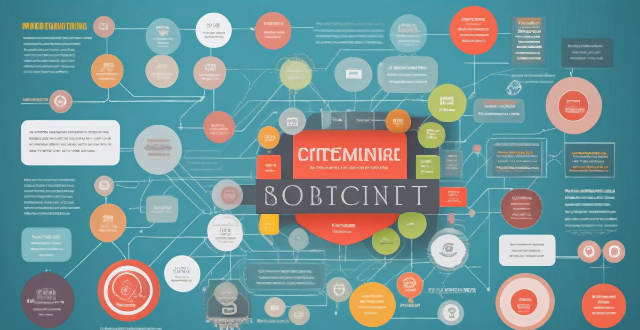Contract Code

What is a smart contract ?
Smart contracts are self-executing contracts with the terms of the agreement between buyer and seller being directly written into lines of code, which exist across a distributed, decentralized blockchain network. They allow for transactions and the transfer or distribution of cryptocurrencies to be executed automatically without the need for a central authority, legal system, or external enforcement mechanism. Smart contracts are autonomous, immutable, traceable, and decentralized. They have various use cases such as cryptocurrency transactions, insurance claims, supply chain management, real estate transactions, gambling and betting, and legal documents. The benefits of smart contracts include efficiency, transparency, security, speed, and accuracy. However, there are challenges and considerations such as code quality, lack of legal recognition, interoperability issues, and privacy concerns.

What is the difference between a regular contract and a smart contract ?
A regular contract and a smart contract differ in terms of their **nature**, **enforceability**, **cost**, **speed**, and **transparency**. Below are the key differences between these two types of contracts: ## Nature ### Regular Contract - Legal agreement between two or more parties. - Typically written in natural language (e.g., English). - Governed by local laws and regulations. ### Smart Contract - Self-executing contract with the terms directly written into code. - Deployed on a blockchain network. - Enforced by the underlying code and cryptographic protocols. ## Enforceability ### Regular Contract - Relies on legal institutions for enforcement (e.g., courts). - May involve mediation or arbitration processes. - Penalties for breach can be monetary or involve other forms of relief. ### Smart Contract - Autonomously executes when predetermined conditions are met. - Enforcement is decentralized and automated. - Penalties for breach are typically programmed into the contract logic. ## Cost ### Regular Contract - Can be costly due to legal fees, notary services, and potential litigation expenses. - Involves overhead of paper-based record keeping and manual processing. ### Smart Contract - Generally less expensive because it eliminates intermediaries. - Costs associated with blockchain transaction fees and contract deployment. ## Speed ### Regular Contract - Time-consuming process from negotiation to signing and execution. - Settlement times can vary widely depending on the complexity of the agreement. ### Smart Contract - Faster execution once the conditions are met. - Real-time settlements possible due to automation. ## Transparency ### Regular Contract - Limited transparency; only involved parties have access to the contract details. - Requires trust in the counterparty to disclose all relevant information. ### Smart Contract - High transparency; contract code and transactions are visible on the blockchain. - Trust is placed in the immutable and verifiable nature of the blockchain.

How do smart contracts work ?
Smart contracts are self-executing contracts with the terms directly written into code, operating on a decentralized blockchain network. Key features include autonomy, trustless transactions, immutability, and traceability. The working mechanism involves deployment, execution based on predefined conditions, verification through consensus algorithms, and settlement updating contract states. Benefits encompass efficiency, transparency, security, and the removal of intermediaries. Challenges include legal recognition, coding errors, and handling complex logic. Smart contracts revolutionize traditional contract law by enabling secure, automated, and transparent transactions on blockchain networks.

What are the potential risks associated with smart contracts ?
Smart contracts revolutionize digital transactions but pose risks like code vulnerabilities, legal uncertainties, lack of human oversight, interoperability issues, and privacy concerns. Users must understand these potential pitfalls before engaging in smart contract agreements to mitigate adverse outcomes.

What are the legal implications of using smart contracts ?
Smart contracts, self-executing contracts with terms written in code on a blockchain, raise legal questions about enforceability, jurisdiction, privacy, security, and regulatory compliance. Best practices include consulting a legal expert, clearly defining terms, considering jurisdiction, and prioritizing privacy and security.

How can schools address the issue of contract cheating, where students pay others to complete their assignments or exams ?
Addressing contract cheating in schools is crucial for maintaining academic integrity. Effective measures include using advanced plagiarism detection tools, educating students on academic integrity, encouraging open discussions, providing support services, and collaborating with parents and guardians. These strategies can deter students from engaging in contract cheating and promote a culture of original work.

What happens if I enter an invalid coupon code ?
When you enter an invalid coupon code during an online transaction, the following scenarios may occur: 1. Error message 2. No discount applied 3. Limited attempts 4. Customer support In summary, entering an invalid coupon code may result in an error message, no discount being applied, limited attempts to enter a code, and the need for customer support assistance.

What are smart contracts in the context of blockchain ?
Smart contracts are self-executing digital agreements that operate within the blockchain, providing a decentralized and trustless system for transactions. They are created using specific programming languages and deployed onto a blockchain platform. Once conditions are met, smart contracts execute automatically, with each node verifying the process to ensure accuracy. Applications include cryptocurrencies, supply chain management, real estate, insurance, and legal agreements. However, challenges like immutability, complexity, legal standing, and privacy concerns must be addressed.

How do I apply a coupon code to my online purchase ?
Applying a coupon code to your online purchase is easy and can save you money. Here's a step-by-step guide on how to do it: Step 1: Find the Coupon Code First, find the coupon code on the retailer's website or through third-party coupon websites. Make sure to copy the code exactly as it appears. Step 2: Add Items to Your Cart Next, add the items you want to purchase to your cart and proceed to checkout. Step 3: Enter the Coupon Code During the checkout process, enter the coupon code in the designated box. Be careful with capitalization, check for expiration dates, and look for any restrictions. If the code is valid, you should see the discount applied to your total. Step 4: Complete Your Purchase After applying the coupon code, complete the rest of the checkout process as usual, including entering your shipping and payment information. If the code doesn't work, double-check that you entered it correctly and that it hasn't expired or reached its usage limit. If you're still having trouble, contact the retailer's customer service for assistance.

How do I know if a coupon code is still valid ?
Verifying the validity of a coupon code is essential to avoid disappointment during online shopping. Here's how you can ensure that your coupon code is still valid: 1. **Check the Expiration Date**: Most coupon codes come with an expiration date, so make sure to use it before that date. 2. **Visit the Retailer's Website**: Go directly to the retailer's website where you plan to use the coupon and look for their "Promotions" or "Special Offers" section to see if your coupon code is listed. 3. **Read the Fine Print**: Coupon codes often have specific terms and conditions attached to them, so make sure your purchase qualifies under these conditions. 4. **Use a Coupon Code Verification Site**: There are several websites dedicated to verifying coupon codes, such as RetailMeNot, Coupons.com, and Honey. 5. **Contact Customer Service**: If you're unsure about the validity of a coupon code, reach out to the retailer's customer service team for confirmation. 6. **Try Applying the Code at Checkout**: If all else fails, try entering the coupon code during the checkout process to see if it's valid. Additional tips include being wary of scams, checking the retailer's policy on stacking multiple coupon codes, and using browser extensions like Honey or Rakuten (formerly Ebates) which automatically find and apply valid coupon codes at checkout.

Can smart contracts be used in traditional businesses ?
Smart contracts, self-executing contracts with terms written into code, can be used in traditional businesses but have limitations such as legal issues and complexity. They offer advantages like transparency, efficiency, and security but also present challenges like lack of human touch and privacy concerns. Businesses should carefully consider their specific needs before adopting this technology.

Do all products or services qualify for coupon code discounts ?
Not all products or services qualify for coupon code discounts, as the availability and applicability of these codes depend on factors such as retailer policies, promotional objectives, and product categories. Retailer policies vary, with some offering discounts on a wide range of items while others restrict them to certain categories or specific products. Coupon codes are often time-bound and may change over time based on the retailer's promotional calendar. Promotional objectives also play a role, as retailers might use coupon codes to clear out old inventory or promote new products, targeting specific customer segments. Product categories can be excluded from discounts due to their high value or low margins, and bulk purchases may not qualify for discounts. Common exclusions include gift cards, shipping fees, and sale items. As a consumer, it is essential to read the terms and conditions associated with each coupon code carefully to ensure its applicability to your desired purchase.

Can I combine a coupon code with other discounts or promotions ?
This article explores the possibilities and limitations of combining different types of discounts such as coupon codes, percentage off, fixed amount off, free shipping, buy one get one (BOGO) offers, and loyalty points while shopping online. The success of stacking these discounts largely depends on the retailer's policy. However, there are some general guidelines that can help shoppers maximize their savings. For instance, coupon codes generally cannot be combined with another percentage off discount but may work alongside fixed amount off offers or free shipping deals. Loyalty points are usually allowed to be used alongside coupon codes. To effectively stack discounts, shoppers should read terms carefully, shop during sale events, sign up for newsletters, use price comparison tools, and contact customer service for clarification when needed.

What are some common mistakes that new programmers make while learning to code ?
New programmers often make mistakes due to lack of planning, ignoring basics, code quality issues, misunderstanding language specifics, neglecting testing, overlooking version control, copying and pasting code without understanding, ignoring best practices, overcomplicating things, and not asking for help soon enough. To avoid these common pitfalls, new programmers should stay curious and humble, practice good programming habits, embrace iteration, use available resources, reflect on mistakes, and plan before coding. Making mistakes is part of the learning process, and the key is to recognize them, understand why they occurred, and ensure they become valuable lessons for future success.

Are there any hidden fees or contracts associated with upgrading my broadband ?
When upgrading broadband, beware of early termination fees, equipment rental costs, and installation charges. Also, understand contract minimums and auto-renewal clauses before committing.

What are the benefits of using smart contracts ?
Benefits of Using Smart Contracts Smart contracts are self-executing contracts with the terms of the agreement between buyer and seller being directly written into lines of code. They offer a range of benefits including automation, transparency, security, efficiency, and cost savings. By automating processes and reducing the need for intermediaries, smart contracts can save time and money, as well as reduce the risk of errors or fraud. They are secured by cryptography, which makes them extremely difficult to hack or manipulate. This security feature can be particularly useful in situations where sensitive information needs to be shared between parties. Smart contracts can also lead to cost savings by reducing the need for intermediaries or third parties. As blockchain technology continues to evolve, it is likely that we will see even more innovative uses for smart contracts in the future.

How can smart contracts be used to streamline financial transactions ?
Smart contracts can streamline financial transactions by automating processes, reducing costs, and increasing efficiency. They can automate payments and transfers, act as escrow services, create loan agreements, streamline insurance claims, and facilitate trading and exchanges of financial assets. As blockchain technology evolves, we can expect more innovative uses for smart contracts in the financial industry.

Are there any restrictions when using a coupon code ?
Coupon codes often have restrictions such as expiration dates, minimum purchase amounts, product restrictions, one-time use, and combination restrictions. It's important to understand these limitations to maximize savings and avoid frustration during checkout.

How do I switch to a new mobile operator ?
Switching to a new mobile operator involves researching the new operator's coverage and plans, checking phone compatibility, contacting current and new operators, signing up with the new operator, activating the new SIM card, and cancelling the old contract.

Can I use multiple promo codes for a single purchase ?
This topic summary discusses the possibility of using multiple promo codes for a single purchase, emphasizing general rules and common practices. Most platforms restrict the use of promo codes to one per order, but there are exceptions where code stacking is allowed under certain conditions. The benefits include greater savings, but it can also add complexity and risk abandoned shopping carts. To navigate this effectively, read terms carefully, check for updates, and contact customer service for clarification.

What are the benefits of hiring a sports agent for career management ?
Hiring a sports agent can bring numerous benefits to an athlete's career management, including negotiating contracts and deals, marketing and branding assistance, legal representation, and career planning and development. By working with an experienced sports agent, athletes can focus on their performance while leaving the business side of their careers in capable hands.

Are there any risks associated with investing in DeFi ?
Investing in DeFi comes with risks such as smart contract vulnerabilities, impermanent loss, regulatory uncertainty, and lack of transparency. It is important for investors to carefully evaluate these risks before investing in any DeFi project.

How do I find and manage my Apple ID verification codes ?
The text provides a comprehensive guide on how to find and manage Apple ID verification codes for enhanced account security. It emphasizes the importance of keeping trusted contact information updated, checking devices for received codes, and using the Settings app for generating codes. Additionally, it outlines steps for managing verification codes, such as updating trusted contact info, adding or removing trusted devices, generating app-specific passwords, reviewing security alerts, and regularly checking for unauthorized activity. The guide underscores the necessity of maintaining updated contact details and being vigilant about account activities to ensure the security of one's Apple ID.